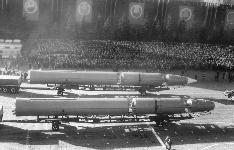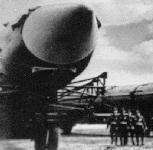





The GR-1 (8K713) Fractional Orbital Bombardment System [FOBS] intended to overcome the ABM-system that the USA was about to deploy in order to protect selective ICBM deployment sites from a Soviet nuclear strike. The GR-1 orbital missile was supposed to be capable of placing a warhead in a low earth orbit of 150 km, braking during its trajectory and targeting the warhead on the earth surface. Its target accuracy was 5 km along range and 3 km on azimuth deviation at unlimited range.
The three-stage liquid cryogenic propellant missile had a launch weight of 117 tons and carried a single warhead with a yield of 2.2 MT. Since the R-9A was reaching the end of their service, it was planned that the GR-1 missile would use the same launching sites as the R-9A missile.
The design of a missile that could serve both as a ballistic and an orbital missile began at Korolev's OKB-1 in 1961. The development of the GR-1 missile was officially authorized by the Ministerial Council on 24 September 1962. Further development of the GR-1 missile was halted in 1964 in preference of the orbital R-36 missile (8K69).
Although the GR-1 missile had not been flight tested, it was paraded in Red Square and did receive the US-designation SS-X-10 SCRAG. It was displayed in a 1965 parade, where it was described as a sister to the manned spacecraft launch vehicles. This missile was correctly identified as being a FOBS configuration, although open sources at the time evidently assumed that the FOBS parading in Red Square and the FOBS undergoing flight tests were the same system. In fact, the initial FOBS flight tests were conducted by the competing UR-200 missile, and subsequent orgital tests by a variant of the R-36. It is unclear when US intelligence understood that the parade missile and the test missile were two different systems.
Specifications | ||
|
DIA |
||
|
NATO |
Scrag |
|
|
Bilateral |
||
|
Service |
GR-1 |
|
|
OKB/Industry |
8K713 |
|
|
Design Bureau |
OKB-1 (Acad. S. P. Korolev) |
|
|
Approved |
9/24/1962 |
|
|
Years of R&D |
||
|
Engineering and Testing |
||
|
First Flight Test |
10/20/64 One to eight flights suggested. All missed through 1967 by U.S. Intelligence. |
|
|
IOC |
Canceled 11/19/68 |
|
|
Deployment Date |
Not deployed |
|
|
Type of Warhead |
Single/Orbital |
|
|
Warheads |
1 |
|
|
Yield |
2.2 |
|
|
Payload |
2.5 |
|
|
Total length |
35.305 |
|
|
Total length w/o warhead |
33.9 |
|
|
Missile Diameter (m) |
2.85 |
|
|
Launch Weight (t) |
116 |
|
|
Fuel Weight (t)
|
1st 116 -38.94, = 77.06 2nd 30.76 -10.24,= 20.52 3rd 7.44 -3.84 = 3.6 Total 101.18 |
|
|
Dry weight total (t) |
14.82 - 2.5 payload mass = 12.32 |
|
|
Range (km) |
12,000/40,000 |
|
|
CEP (m) (Russian Sources) |
5,000/3,000 |
|
|
CEP (m) (Western Sources) |
||
|
Number of Stages |
3 |
|
Canister length (m) |
N/A |
|
Canister length w/o front meters (m) |
N/A |
|
Canister diameter (m) |
N/A |
|
Booster guidance system |
Inertial autonomous |
|
1st stage |
2nd stage |
3rd stage |
|
|
Length (m) |
18.0 |
7.7 |
6.4 |
|
Body diameter (m) |
2.85 |
2.7 |
2.35 |
|
Fueled weight (t) |
77.06 |
20.52 |
3.6 |
|
Dry weight (t) |
8.18 |
2.8 |
1.34 |
|
Engine Designation |
NK-9 (8D717) |
NK-9V / (NK-19) |
Derivation of the S1.5400, 8D726 |
|
Design Bureau |
Acad. N. D. Kuznetsov, OKB-276 |
Acad. N. D. Kuznetsov, OKB-276 |
Acad. A.M. Isayev, OKB-2 |
|
Years of R &D |
1959-1965 |
1959-1965 |
1962-1965 |
|
Propellants |
Liquid |
Liquid |
Liquid |
|
Liquid Fuel |
RG-1, Kerosene |
RG-1, Kerosene |
RG-1, Kerosene |
|
Oxidizer |
Oxygen |
Oxygen |
Oxygen |
|
Burning time (sec.) |
|||
|
Thrust Sea Level/Vacuum (tonnes) |
4 x 36.5=147/ 4 x 38=152 |
44.6 -45-46.1 |
6.87-8.5 |
|
Specific Impulse Level/Vacuum (sec.) |
285 - 327 |
330 - 341 |
344 |
|
Basing Mode |
Silo |
|
Hardness |
|
|
Launching Technique |
Hot Launch |
|
Deployed boosters |
0 |
|
Test Boosters |
1-8? |
|
Warheads Deployed |
0 |
|
Deployment Sites |
0 |
|
Training Launchers |
0 |
|
Space Booster Variant |
Yes GR-1 |


